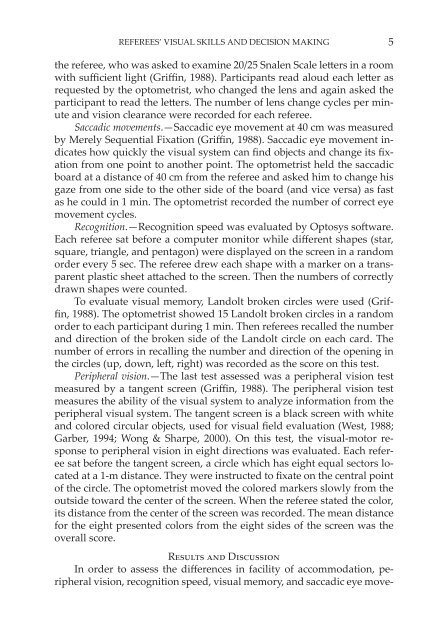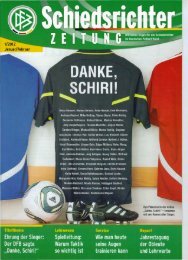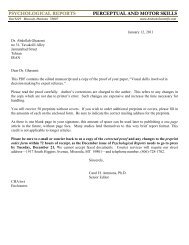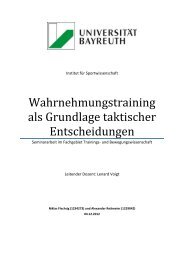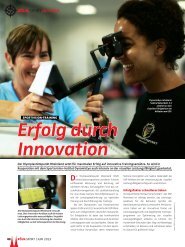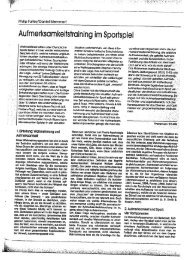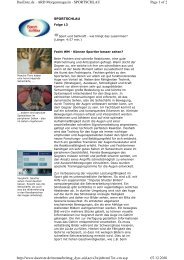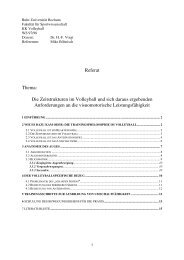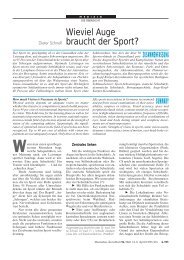psychological reports perceptual and motor skills - Dynamic-Eye
psychological reports perceptual and motor skills - Dynamic-Eye
psychological reports perceptual and motor skills - Dynamic-Eye
Create successful ePaper yourself
Turn your PDF publications into a flip-book with our unique Google optimized e-Paper software.
REFEREES’ VISUAL SKILLS AND DECISION MAKING 5<br />
the referee, who was asked to examine 20/25 Snalen Scale letters in a room<br />
with sufficient light (Griffin, 1988). Participants read aloud each letter as<br />
requested by the optometrist, who changed the lens <strong>and</strong> again asked the<br />
participant to read the letters. The number of lens change cycles per minute<br />
<strong>and</strong> vision clearance were recorded for each referee.<br />
Saccadic movements.—Saccadic eye movement at 40 cm was measured<br />
by Merely Sequential Fixation (Griffin, 1988). Saccadic eye movement indicates<br />
how quickly the visual system can find objects <strong>and</strong> change its fixation<br />
from one point to another point. The optometrist held the saccadic<br />
board at a distance of 40 cm from the referee <strong>and</strong> asked him to change his<br />
gaze from one side to the other side of the board (<strong>and</strong> vice versa) as fast<br />
as he could in 1 min. The optometrist recorded the number of correct eye<br />
movement cycles.<br />
Recognition.—Recognition speed was evaluated by Optosys software.<br />
Each referee sat before a computer monitor while different shapes (star,<br />
square, triangle, <strong>and</strong> pentagon) were displayed on the screen in a r<strong>and</strong>om<br />
order every 5 sec. The referee drew each shape with a marker on a transparent<br />
plastic sheet attached to the screen. Then the numbers of correctly<br />
drawn shapes were counted.<br />
To evaluate visual memory, L<strong>and</strong>olt broken circles were used (Griffin,<br />
1988). The optometrist showed 15 L<strong>and</strong>olt broken circles in a r<strong>and</strong>om<br />
order to each participant during 1 min. Then referees recalled the number<br />
<strong>and</strong> direction of the broken side of the L<strong>and</strong>olt circle on each card. The<br />
number of errors in recalling the number <strong>and</strong> direction of the opening in<br />
the circles (up, down, left, right) was recorded as the score on this test.<br />
Peripheral vision.—The last test assessed was a peripheral vision test<br />
measured by a tangent screen (Griffin, 1988). The peripheral vision test<br />
measures the ability of the visual system to analyze information from the<br />
peripheral visual system. The tangent screen is a black screen with white<br />
<strong>and</strong> colored circular objects, used for visual field evaluation (West, 1988;<br />
Garber, 1994; Wong & Sharpe, 2000). On this test, the visual-<strong>motor</strong> response<br />
to peripheral vision in eight directions was evaluated. Each referee<br />
sat before the tangent screen, a circle which has eight equal sectors located<br />
at a 1-m distance. They were instructed to fixate on the central point<br />
of the circle. The optometrist moved the colored markers slowly from the<br />
outside toward the center of the screen. When the referee stated the color,<br />
its distance from the center of the screen was recorded. The mean distance<br />
for the eight presented colors from the eight sides of the screen was the<br />
overall score.<br />
Results <strong>and</strong> Discussion<br />
In order to assess the differences in facility of accommodation, peripheral<br />
vision, recognition speed, visual memory, <strong>and</strong> saccadic eye move-


